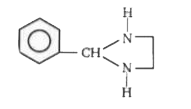Which of the following compounds is most acidic ?
C6H5COOH
ClCH2COOH
BrCH2COOH
O2NCH2CH2COOH
The correct Answer is:B
To determine which of the given compounds is the most acidic, we need to analyze the stability of their conjugate bases. The compounds in question are:
1. Benzoic acid (C6H5COOH)
2. Chlorocytic acid (ClC6H4COOH)
3. Bromide acid (BrC6H4COOH)
4. Nitro-propanoic acid (NO2C3H6COOH)
Step 1: Identify the conjugate bases of each acid.
- For benzoic acid, the conjugate base is benzoate ion (C6H5COO⁻).
- For chlorocytic acid, the conjugate base is chlorobenzoate ion (ClC6H4COO⁻).
- For bromide acid, the conjugate base is bromobenzoate ion (BrC6H4COO⁻).
- For nitro-propanoic acid, the conjugate base is nitro-propanoate ion (NO2C3H5COO⁻).
Hint: The conjugate base is formed when the acid donates a proton (H⁺).
Step 2: Analyze the stability of each conjugate base.
- The stability of the conjugate base is crucial for determining the acidity of the corresponding acid. The more stable the conjugate base, the stronger the acid.
- Benzoate ion is stabilized by resonance, as it has two equivalent resonance structures.
- Chlorobenzoate ion is also stabilized by resonance, but the presence of the electron-withdrawing chlorine atom increases its stability further compared to benzoate ion.
- Bromobenzoate ion is less stable than chlorobenzoate because bromine is a weaker electron-withdrawing group than chlorine.
- Nitro-propanoate ion has the nitro group, which is a strong electron-withdrawing group, but its position relative to the carboxyl group affects its overall stability.
Hint: Electron-withdrawing groups stabilize the conjugate base by delocalizing negative charge.
Step 3: Compare the stability of the conjugate bases.
- Benzoate ion: Stable due to resonance.
- Chlorobenzoate ion: More stable than benzoate due to the electron-withdrawing effect of chlorine.
- Bromobenzoate ion: Less stable than chlorobenzoate due to the weaker electron-withdrawing effect of bromine.
- Nitro-propanoate ion: While the nitro group is a strong electron-withdrawing group, its position (alpha position) may not stabilize the conjugate base as effectively as the chlorine in chlorobenzoate.
Hint: The position of substituents matters; electron-withdrawing groups are more effective when they are closer to the carboxyl group.
Step 4: Conclusion on acidity.
After analyzing the stability of the conjugate bases, we conclude that chlorocytic acid (chlorobenzoate ion) has the most stable conjugate base due to the strong electron-withdrawing effect of chlorine. Therefore, chlorocytic acid is the most acidic among the given compounds.
Final Answer: Chlorocytic acid is the most acidic compound.
2. Chlorocytic acid (ClC6H4COOH)
3. Bromide acid (BrC6H4COOH)
4. Nitro-propanoic acid (NO2C3H6COOH)
- For benzoic acid, the conjugate base is benzoate ion (C6H5COO⁻).
- For chlorocytic acid, the conjugate base is chlorobenzoate ion (ClC6H4COO⁻).
- For bromide acid, the conjugate base is bromobenzoate ion (BrC6H4COO⁻).
- For nitro-propanoic acid, the conjugate base is nitro-propanoate ion (NO2C3H5COO⁻).
- The stability of the conjugate base is crucial for determining the acidity of the corresponding acid. The more stable the conjugate base, the stronger the acid.
- Benzoate ion is stabilized by resonance, as it has two equivalent resonance structures.
- Chlorobenzoate ion is also stabilized by resonance, but the presence of the electron-withdrawing chlorine atom increases its stability further compared to benzoate ion.
- Bromobenzoate ion is less stable than chlorobenzoate because bromine is a weaker electron-withdrawing group than chlorine.
- Nitro-propanoate ion has the nitro group, which is a strong electron-withdrawing group, but its position relative to the carboxyl group affects its overall stability.
- Benzoate ion: Stable due to resonance.
- Chlorobenzoate ion: More stable than benzoate due to the electron-withdrawing effect of chlorine.
- Bromobenzoate ion: Less stable than chlorobenzoate due to the weaker electron-withdrawing effect of bromine.
- Nitro-propanoate ion: While the nitro group is a strong electron-withdrawing group, its position (alpha position) may not stabilize the conjugate base as effectively as the chlorine in chlorobenzoate.
After analyzing the stability of the conjugate bases, we conclude that chlorocytic acid (chlorobenzoate ion) has the most stable conjugate base due to the strong electron-withdrawing effect of chlorine. Therefore, chlorocytic acid is the most acidic among the given compounds.
Similar Questions
Knowledge Check
Which of the following compounds has most acidic hydrogen ?
A B
B C
C D
D
Which of the following compounds is most stable ?
A B
B C
C D
D
Which of the following compound is most acidic? Cl2O7, P4O10, SO3 B2O3
View SolutionWhich of the following compound is most acidic? Cl2O7, P4O10, SO3 B2O3
View SolutionWhich of the following compounds is most basics
View SolutionWhich of the following compounds is the most acidic ?
View SolutionWhich one of the following compounds is most acidic
View SolutionWhich one of the following compounds is most acidic
View Solution
